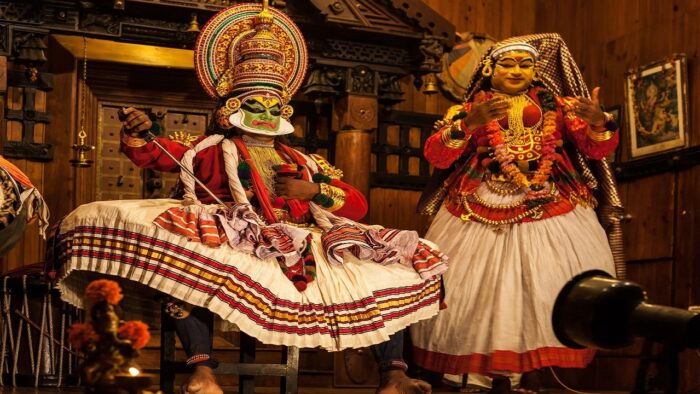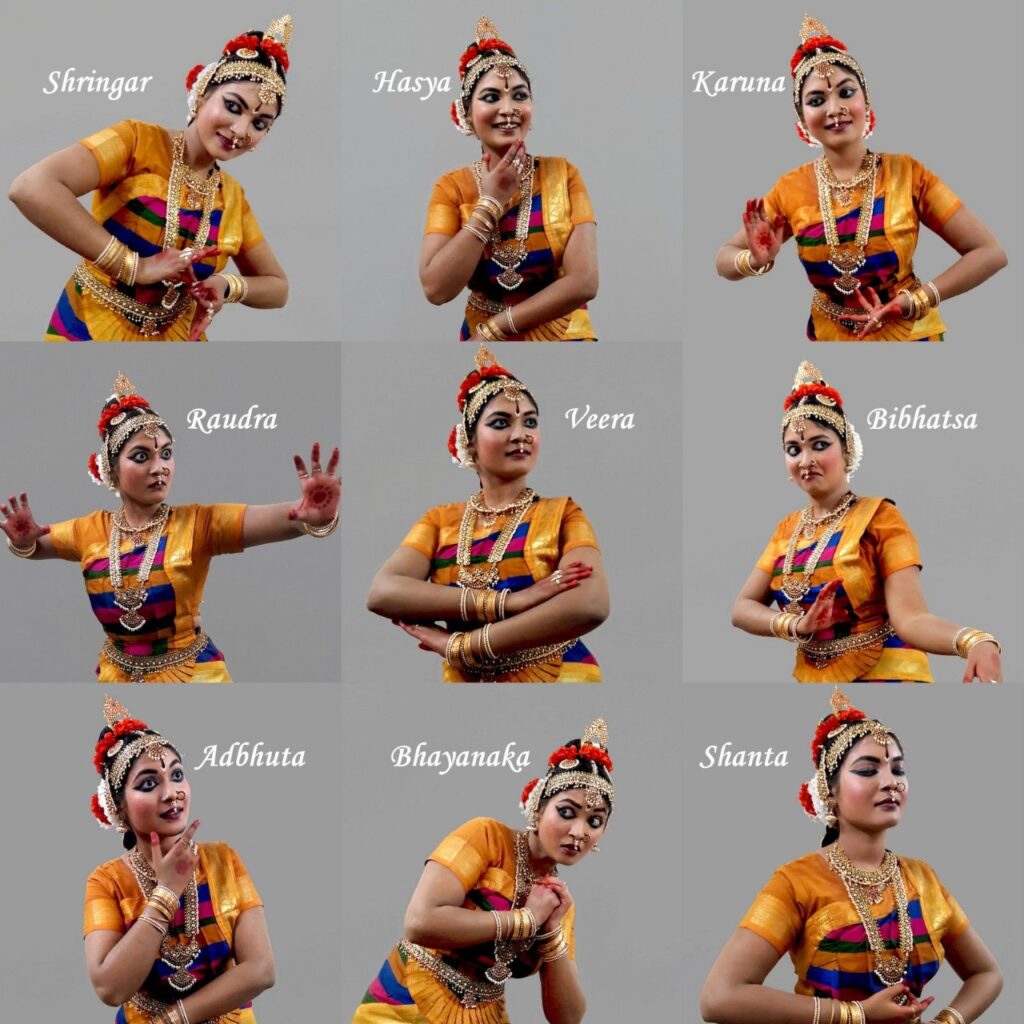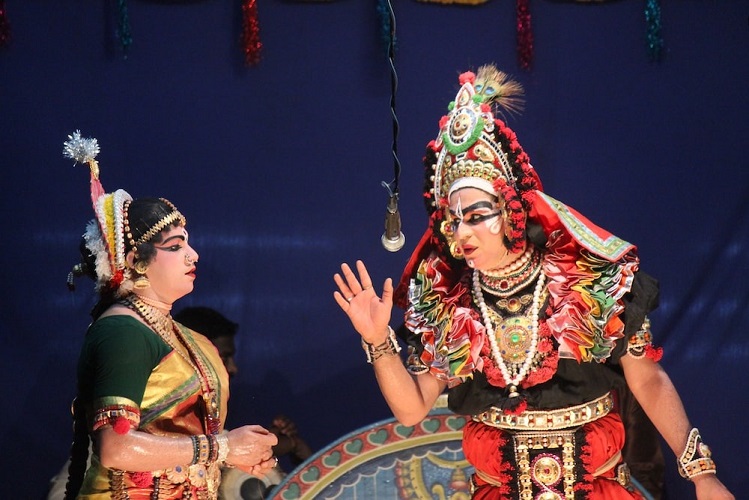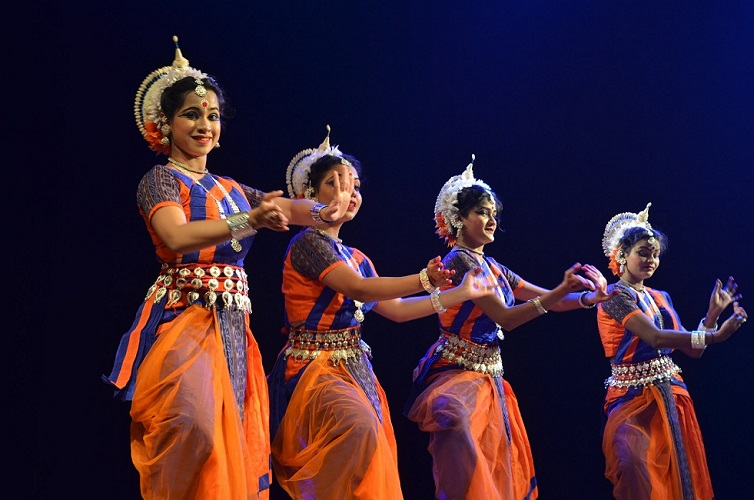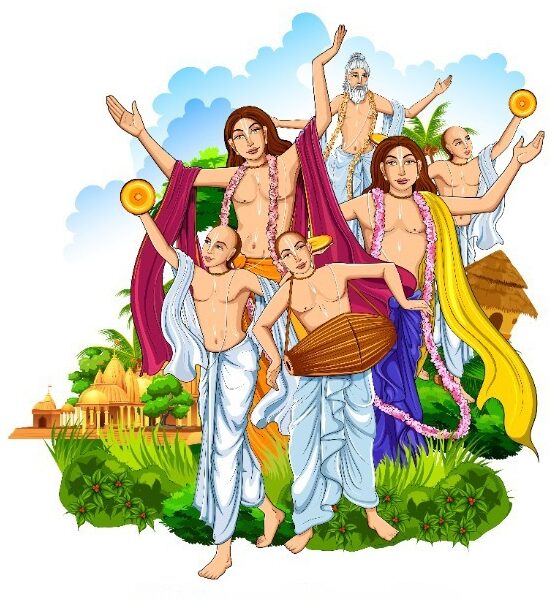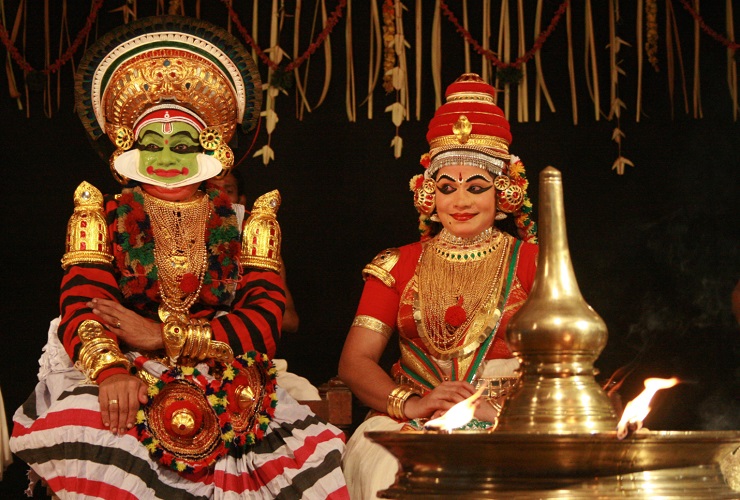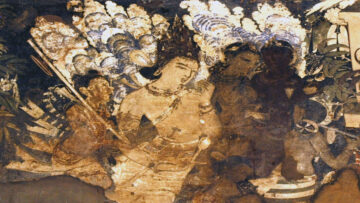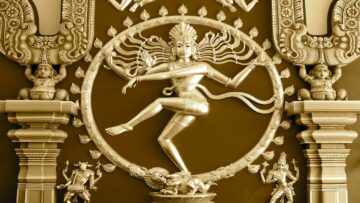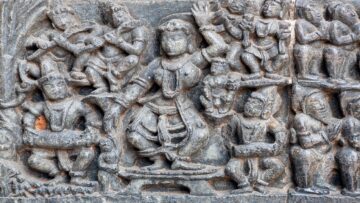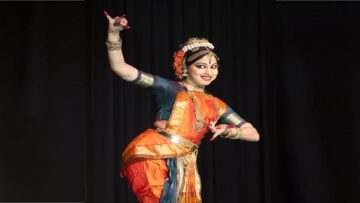I. Rasa in Nāṭya
Rasa Theory is the earliest aesthetic theory in our tradition and appears to be the first in the world. The Nāṭyaśāstra of Bharata is the oldest surviving text and as it mentions earlier works, we cannot pinpoint when it may have first originated. The Nāṭyaśāstra discusses Rasa in the context of the performing arts, comprising of dialogue, enactment, songs, music and dance in theatre. As drama is all about emotions and their expression, many types of bhavas are discussed in the Nāṭyaśāstra. So bhavas are both, the sentiments expressed and the sentiments they evoke.
Sthāyī bhāvas are the basic dormant emotions that are in all human beings which can be brought to the fore by the characters and scenes depicted in the play with suitable dialogues and dance. The Rasa discussion does not aim to catalogue all possible human emotions but only to understand those relevant in a dramatic representation. A dramatic performance should not be neutral or insipid but aim to create a particular mood which the audience can merge with and enjoy. When the dramatic representation evokes a particular mood or sentiment to a high degree, the aesthetic relish is known as Rasa experience.
(Figure 1: Credit: Wallpaper access)
There are eight moods listed as dynamic in drama, listed along with the basic human emotion called sthāyī bhāvas, which are the foundation for the respective rasas – śŗńgāra (Rati), Hāsya (Hāsa), Vīra (Utsāha), Adbhuta (Vismaya), Bībhatsa (Jugupsā), Bhayānaka (Bhaya), Raudra (Krodha) and Karuņa (śoka). A ninth rasa, śānta (śama) is also well-known, corresponding to beatitude, which evokes the calmness of moksha that Indian philosophy teaches.
रस-सूत्रः – विभाव-अनुभाव-व्यभिचारि-संयोगात्-रसनिष्पत्तिः।
The Rasa Sūtra in chapter 6 of Nāṭyaśāstra is:
Vibhāva-anubhāva-vyabhicāri-samyogat rasaniṣpattiḥ.
This is a very simple explanation that is still relevant today, applicable to the best of productions in Broadway or London. It simply states that the combination of vibhāvas, anubhāvas and vyabhicāri bhāvas in a performance evoke Rasa. The different dramatic representations foster different emotional response, some strengthening the development of an overall rasa, while others give relief against its backdrop. It is not recommended that emotions contrary to the rasa be evoked so as to weaken the impact. Hence the choreographer or director should choose judiciously to achieve success of the performance.
In Chapter VĪ, the various Bhāvas are defined and discussed. They are termed as such since they cause an emotional response in the audience and communicate the meaning of the poetry (or dramatic literature) through the four different abhinayas, which are Āńgika, Sāttvika, Vācika and Āhārya.
भावा इति कस्मात्।किंभवन्तीति भावाः किंवाभावयन्तीति भावाः।
उच्यते – वाग्-अङ्ग-सत्त्व-उपेतान्काव्यार्थान्भावयन्तीति इति।
भू इति करणे धातुस्तथा च भावितं वासितं कृतमित्यर्थान्तरम्।
लोकेऽपिचप्रसिद्धम्।अहो ह्यनेन गन्धेन रसेन वा सर्वमेव भावितमिति।
तच्चव्याप्त्यर्थम्।
अत्राह – रस इति कःपदार्थः? उच्यते – आस्वाद्यत्वात्। —— सुमनसःप्रेक्षकाःहर्षादींश्चाधिगच्छन्ति।( Nāṭyaśāstra page 237- 243)
Bhāvā iti kasmāt? Kiṃ bhavantīti bhāvāḥ kiṃ vā bhāvayantīti bhāvāḥ | ucyate – vāgańgaśattvopetān kāvyārthān bhāvayantīti iti | bhū iti karaņe dhātustathā ca bhāvitaṃ vāsitaṃ kŗtamityarthāntaram | loke’pi ca prasiddham | aho hyanena gandhena rasena vā sarvameva bhāvitamiti | tacca vyāptyartham|
Atrāha – rasa iti kaḥ padārthaḥ? ucyate – āsvādyatvāt | ……sumanasaḥ prekṣakāḥ harṣādīṃścādhigacchanti |
Why are they called bhāvas? Is it because they exist or because they cause? The answer: It is because they cause the meaning of the poetry to be conveyed through speech, gestures and emotional expressions. The verb root ‘bhū’ is in the sense of an agent and also means expresses or pervades. In the world it is well known. We have expressions such as – Oh, by this fragrance or flavor this whole place is evoked. It is in the sense of being pervaded. Here he says that it is rasa because it is relished, spectators with a conducive mind attain delight and other sensations.
Abhinavagupta has clearly stated that this feeling of joy or thrill or bliss cannot be explained by any of the 4 or even 6 Pramāņas, or means to valid knowledge, of the rational world. This is the chief reason that it is called alaukika, or beyond the mundane world of everyday transactions. The Rasika loses the sense of time and space of his personal existence and merges with the world that is staged. The Rasa experience transcends the normal world of daily existence in terms of personal involvement, profit and loss, or cause-and-effect equations. The situation may be unreal, staged, but the emotional response is real.
We look at Abhinavabhāratī –
स च विभावादिबलादिति भावा वक्तव्याः।तत्र नाज्ञातलौकिकरत्यादिचित्तवृत्तेः कवेर्नटस्यवा तद्विषयविशिष्टविभावाद्याहरणं शक्यमिति स्थायिन उद्दिष्टाः। (page 23)
Sa ca vibhāvādibalāditi bhāvā vaktavyāḥ | tatra nājñātalaukikaratyādicittavŗtteḥ kavernaṭasya vā tadviṣayaviśiṣṭavibhāvādyāharaņaṃśakyamiti sthāyina uddiṣṭāḥ |
Nāṭyaśāstra – Bhāvāḥ – Seventh Chapter:
भावाः – अध्याय७ –
अथ विभावा इति कस्मात् – उच्यते – विभावो विज्ञानार्थः विभावः कारणं निमित्तं हेतुरितिपर्यायाः। विभाव्यन्तेऽनेन वागङ्गसत्त्वाभिनया इत्यतो विभावः।यथा विभावितं विज्ञातमित्यनर्थान्तरम्। (page 250)
Atha vibhāvā iti kasmāt – vibhāvo vijñānārthaḥ vibhāvaḥ kāraņaṃ nīttaṃ heturiti paryāyā ḥ | vibhāvyante’nena vāgańgasattvābhinayā ityato vibhāvaḥ| yathā vibhāvitaṃ vijñātamityarthāntaram |
अथानुभाव इति कस्मात्।उच्यते – अनुभाव्यतेऽनेनवागङ्गसत्त्वकृतोऽभिनय इति। (p251)तत्र विभावानुभावौलोकप्रसिद्धौ।लोकस्वभावानुगतत्वाच्चतयोर्लक्षणंनोच्यतेऽतिप्रसङ्गनिवृत्त्यर्थम्। (p 253)
Athānubhava iti kasmā t | ucyate – anubhā vyate’nena vā gańgasattvakŗto’bhinaya iti | tatra vibhāvānubhāvau lokaprasiddhau | lokasvabhāvānugatatvācca tayorlakṣaņaṃ nocyate’tiprasańganivŗttyartham |
The vibhāvas are the causes that generate the emotional response in the audience and initiate the mood. The anubhāvas are the ensuing reactions depicted by the actors that further the story and mood. Since these are well-known in the world, from real life, they need not be taught in the text but selected according to episodes of the story.
By the time we come to the ninth century CE onwards, we find a distinct shift in Nāṭya texts towards dance in particular, whereas the earlier Nāṭyaśāstra dealt with drama in totality. Rūpaka had given way to Uparūpaka which had dance predominantly. The Sangītaratnākara (13th century) speaks of Rasa and the nine rasas as follows as depicted by vibhāvas, anubhāvas in the actors that initiate an emotional response based on the basic instinctive dormant emotions of man, without a personal involvement of attachment or enmity towards the causes in drama that create the emotional response. (Verses 1352, 1353)
II. Rasa in Kavya
(Figure 2: Credit: Unsplash)
Even before the time of Abhinavagupta, the Rasa theory came to be recognized as a general theory of aesthetic experience and we see it applied to literature. Poetry was usually heard, through recitation in Harikathā or Rāmāyaņa-Mahābhāratapārāyaņas, perhaps with instrumental accompaniment. The core concept of the situation being invoked in the imagination through story-telling, with the characters and events of the narrative providing the vibhāvas, anubhāvas and sañcāribhāvas that evoke the emotional response that the poet envisages. This unity of the audience with the poet is the Rasa experience and the connoisseur is called a Sahŗdaya. The Dhvanyāloka is a seminal text by Anandavardhana that describes Rasa in literature in detail. Rasa in literature is called Dhvani.
ध्वन्यालोकः –
अयमेव हि महाकवे र्मुख्योव्यापारो यद्रसादीनेवमुख्यतया काव्यार्थीकृत्य तद्व्यक्त्यनुगुणत्वेनशब्दानामर्थानां चोपनिबन्धनम्।
एतच्चरसादितात्पर्येण काव्यनिबन्धनं भरतादावपि सुप्रसिद्धमेवेति – – – -।रसादयोहिद्वयोरपितयोः (काव्यनाट्ययोः) जीवभूताः। “सारभूतो ह्यर्थः स्वशब्दानभिधेयत्वेन प्रकाशितः सुतरामेवशोभामावहति।
प्रसिद्धिश्चेयमस्त्येवविदग्धविद्वत्परिषत्सुयदभिमततरं वस्तुव्यङ्ग्यत्वेनप्रकाश्यते न साक्षाच्छब्दवाच्यत्वेनैवच।“
Ayameva hi mahākavermukhyo vyāpāro yadrasādīneva mukhyatayā kāvyārthīkŗtya tadvyaktyanuguņatvena śabdānāmarthānāṃ copanibandhanam | etacca rasāditātparyeņa kāvyanibandhanaṃ bharatādāvapi suprasiddhameveti ….| rasādayo hi dvayorapi tayoḥ (kāvyanāṭyayoḥ) jīvabhūtāḥ | “sārabhūto hyarthaḥ svaśabdā nabhidheyatvena prakāśitaḥ sutarāmeva śobhāmāvahati | prasiddhiśceyamastyeva vidagdhavidvatpariṣatsu yadabhimatataraṃ vastu vyańgyatvena prakāśyate na sākṣācchabdavācyatvenaiva ca |”
The chief purpose of both literature and drama is to evoke rasa. With this in mind, great works of literature narrate the story to initiate a suitable response in the reader. This is seen even in such works as Mahābhārata. Profound and lofty meanings are expressed with effective words. But what delights the connoisseurs even more is the power of suggestion and it is the hinted meaning that forms the true charm of poetry.
Therefore, a Rasika with a keen imagination and saṃskāra or familiarity with the cultural representation, is moved to Rasa experience with the poetry. A person with less imagination is assisted by the visual aspects of the dramatic representation with abhinaya, music and dance to vividly see the situation and thence experience Rasa.
III. Art in General – Theory and Technique
(Figure 3: Credit: Flickr)
मम्मट – मङ्गलश्लोकः
नियतिकृतनियमरहितां ह्लादैकमयीमनन्यपरतन्त्राम्।
नवरसरुचिरां निर्मितिमादधती भारती कवेर्जयति॥१॥
niyatikŗtaniyamarahitāṃ hlādaikamayīmananyaparatantrāṃ |
navarasarucirāṃ nirmitimādadhatībhāratī kaverjayati || 1 ||
The poetś voice is not bound by the rules of nature, consists of unalloyed delightfulness, free from external control, formed by the nava rasas, it triumphs over reality. With Mammata’s opening verse in the Kāvyaprakāśa, we can see that the rasa theory that explains aesthetic relish is in fact a generalized theory of art experience. When we think of art, it is not possible to imagine an abstract form of art, but we can only envisage some particular form of art, such as painting, sculpture, poetry, music or dance. Art is described as both, subjective as well as objective. The technique and norms of style define the objective aspect while the subjective aspect is dependent on the appreciation of the Rasika.
While the creative urge may be similar, there is no denying that the medium makes them very different. Forms such as architecture or modern automobile design are largely driven by utility. Going by western criticism, we are left with contrasting an abstract concept of art with the techniques of that particular field of art.
The influence of dramatic art can be seen in the visual arts such as painting and sculpture. When stories of the Purāņas are depicted, it is natural that they evoke similar emotions as when the story is narrated, recalling the vibhāvas, anubhāvas etc. We have many palm leaf manuscripts and miniature paintings that are inspired by drama and literature in general. The Aṣṭa Nāyikās described under Sŗńgārarasa in Nāṭyaśāstra are very popular in Rajasthani and Mughal paintings, often accompanying poetry manuscripts. Symbolism is also very important in Indian art, especially in temple sculpture. For example, the Nataraja statue is recognized the world over as a masterpiece of iconic art, but not only is it a beautiful composition, but also symbolizes the five elements and the five kriyās of Lord Shiva.
While an abstract description of what is may be found scattered in many texts, it is important to note that in all areas of artistic endeavor, techniques of achieving perfection were well understood, while at the same time creativity was also encouraged. By defining Guņas and Doṣas, a technique was made clear to practitioners. The Nāṭyaśāstra gives detailed description of a myriad of techniques but always exhorts the actor to use them with innovation and novelty. The psychological process of art appreciation along with the details of technique together creates a specific form or style of art.
In music, Rāgas are always explained in detail to denote specific musical modes that suit relevant mood or rasa. In addition, Rāgas have their own specific Vādī svara, which is frequently sounded, as also the Saṃvādī svara, which comes next in importance. A Vivādī svara is also specified, which is to be avoided. A set of notes are selected to form a Rāga for sheer aesthetic harmony; notes that would jar are avoided. While it is clearly understood what notes will harmonize and what will not, can anybody explain why some notes sound pleasant together while others do not? It would depend on much speculation that may not be acceptable to everybody! In the modern context, we may understand notes better in terms of wavelength and frequency etc., but the aesthetic preference is still unexplained. As regards other disciplines such as architecture etc., we need to study more texts of ancient India to understand the principles of aesthetics that they may contain.
IV. Bhakti Rasa
(Figure 4: Credit: iStock)
In satsańgs and bhajans, the concept of rasa in kāvya is extended to the feeling of deep devotion or bhakti. It is not a removed feeling of enjoying literature but is a more personal involvement. Here again, the vibhāvas, anubhāvas and vyabhicāris are defined in both, the literature as well as the emotions that the devotee goes through. In the sixteenth century, Rupa Goswami, a follower of the saint Chaitanya Mahaprabhu wrote the Bhaktirasāmŗtasindhu, which delineates in detail all aspects of Bhakti rasa.
He defines that the deep devotion of the mind on Lord Vishnu, with constant contemplation of His wonderful qualities, is known as Bhakti. This Bhakti is classified into three main types, Sādhana, Bhāva and Prema bhakti. Sādhana refers to the activities and lifestyle that foster devotion to Lord Vishnu, that help direct our existence to constant thoughts of the Supreme. When Sādhana is practiced for a length of time, it has a sāttvic effect on the mind and the devotee becomes aware of a deep involvement with the Lord. This leads to Bhāva bhakti when the devotee is constantly absorbed in thoughts of Sri Krishna. When this emotional feeling reaches a crescendo and the devotee feels a flush of love towards the Lord, it is called Prema bhakti.
अन्याभिलाषिताशून्यं ज्ञानकर्माद्यनावृतम्।
आनुकूल्येनकृष्णानुशीलनं भक्तिरुत्तमा॥१ – ११॥
सर्वोपाधिविनिर्मुक्तं तत्परत्वेननिर्मलम्।
हृषीकेण हृषीकेशसेवनं भक्तिरुच्यते॥१२॥
anyābhilāṣitaśūnyaṃ jñānakarmādyanāvŗtam |
ānukūlyena kŗṣņānuśīlanaṃ bhaktiruttamā || I. 11 ||
sarvopādhivinirmuktaṃ tatparatvena nirmalam |
hŗṣīkeņa hŗṣīkeśasevanaṃ bhaktirucyate || 12 ||
Devotion to Lord Krishna free from constraints undertaken due to attachment to rituals or knowledge, with no other desire, is the most superior form of worship. It is pure, with no shade of pollution with other ambitions, to serve Hrshikesha with a joyous heart is called pure devotion, or bhakti.
The primary bhakti rasas are classified as śānta rasa, Prīti rasa, Preyo rasa, Vatsala rasa and Madhura rasa. The secondary rasas are classified according to the other eight rasas of Nāṭya.
V. Some Problems in Modern Interpretation
(Figure 5: Credit: Wikimedia Commons)
Many modern writers are unnecessarily defensive that Indian tradition did not address the issue of what pure art is, which seems to be quite unfounded. What is pure art? Western Indologists seem to think it adequate to form clever questions but we need to see if there are any answers. Was there any form of art in Europe or elsewhere in the world in bygone centuries that was not in India? Were there any abstract artists, just kalākāras, anywhere in the Western world, without specific reference to the particular form of art? If you called a person an artist, wouldn’t you also be able to say what form of art it is? Ancient Indian concepts should be compared with the ancient world, not simply juxtaposed with modern times.
Consider the following quotation from The Rasa Reader published by Columbia University written by Sheldon Pollock which purports to be a comprehensive manual on Rasa for scholars.
“For one thing, there was no unified sphere with a particular designation we could translate by the English term “art”. There were separate cultural domains of poetry (kavya), drama (Natya), music (samgita, consisting of vocal and instrumental music and dance), and less carefully thematized practices, with terminology also less settled, including painting (citra), sculpture (often pusta), architecture (for which there was no common term at all), and the crafts (kala), which could include many of the preceding when that was deemed necessary. In these disparate domains there was never any dispute, at least overtly, about what was and was not to be included, though sometimes works passed into and out of a given category according historically changing reading or viewing practices. Furthermore, almost everything outside the literary realm, let alone the cultural realm, remained outside classical Indian aesthetic analysis (including nature: though Shiva was a dancer, God in India was generally not an artist.)” (Rasa Reader: Introduction, section 1)
There are several problems in the above paragraph. Texts of Saiva Tantra dating back to the early centuries enumerate sixty-four kalās or arts. (Jayā 2006: 39; Full list of 64 arts) Kalā cannot be translated into “craft” any more than the paintings of Botticelli or Michelangelo can be termed as “craft”, as those great “artists” also underwent many years of training and apprenticeship before they could be commissioned for designing and executing artworks. Pusta is wrongly translated as sculpture; it is art put together with glue, paper (any cellulose material available at the time), cloth, sticks, paste and paint. Art, artist and artisan are closely related in any society and India was not any different to other cultures of the world in this. As for the meaningless reference to Lord Siva, we may quote David Frawley who says that most Westerners do not go beyond the surface in what they see of Indian culture.
“My intention in the present book is to help correct the distortions about Lord Shiva present in academic and popular accounts, which focus on the sensational side of Shiva and downplay his yogic implications. So far, few thinkers in the West have understood the profound wisdom and meditative insights behind such apparent figures of polytheism and nature worship as epitomized in Lord Shiva.” (Frawley 2016: p 13)
“The western mind tends to reduce Shiva to iconographic and anthropomorphic appearances, which derive from a very different cultural milieu of ancient India.” (Frawley 2016: p 27)
The meaning of vibhāva, anubhāva, vyabhicāri, sthāyī etc. are explained in contrary terms by different writers leading to confusion. The texts are also criticized for not being precise in their definition of these terms as there is overlap. But this seeming overlap is due to the fact that the emotions function in different capacities in creating the mood of drama and are not distinct entities with fixed labels. The “Rasa Reader” of Sheldon Pollock gives new translation of vibhāva as “factor” but does not explain it at all. Anything that has any bearing on the equation at hand is a “factor” and the word conveys no particular information. Barlingay presents a novel interpretation of vibhava by contrasting it with ‘svabhāva’ but is silent on anubhāva.
Other scholars who follow the tradition closely give an accurate explanation. Adya Rangacharya, for instance, translates it as “stimulant,” as it determines the emotional response of the spectator (vi+bhāva = viśeṣeņa bhāvayati). He writes that vibhāva is that which leads to a perception; so vibhāva is a cause (Rangacharya 1986: 55, 64).
The allegation that the Nāṭyaśāstra only speaks of rasa in the character, not in the spectator, that the latter notion appeared only later in the tradition and hence our classical discussions did not have any theory of aesthetics in the abstract sense, wherein aesthetic enjoyment was discussed, is untenable. Please note the words, “discerning viewers relish the stable emotions when they manifest by the acting…” – Nānābhāvābhinayavyañjitān …ṣthāyibhāvān āsvādayanti sumanasaḥprekṣakāḥ harṣādīṃśca adhigacchanti | – (Nāṭyaśastra 1996: 90) in the sentences immediately following the first discussion on rasa in Chapter VI.
Often, the limitations of understanding on the part of modern scholars are represented as limitations of what the ancient texts have stated.
“There is another defect in Bharataś definition of bhava. It, no doubt points out that bhavas are the causes of rasas. But, even though they are created (bhāvayanti), Bharata does not bother to point out that they may still exist (bhavanti). There is no contradiction whatsoever in these two positions. But, in emphasizing the creative aspect, Bharata has either forgotten the existence aspect, or his original text has been interfered with.” – (Barlingay, page 129)
There is much confusion among modern writers in understanding the relation of morality and aesthetic appreciation in Indian tradition. The ancient masters of Poetics are very clear that the two, though different, are combined in fine literature. The issues of Saṃskāra, propriety and morality are often all mixed up in modern writing. Saṃskāra is simply the impressions of previous experience without which we cannot go about our daily tasks such as driving home or shopping in a supermarket but it is confused with mystical issues such as reincarnation. These interpretations make Indian notions appear obsolete and based on superstition, whereas in fact the aesthetic theory is quite adequate to explain events within one’s life, without referring to rebirth. Pollock writes that the notion of Rasa is ‘contingent on reincarnation’, which stretches the notion way beyond reason. (Rasa Reader: Introduction, section 12)
Sometimes, criticism arises simply out of failure to understand the issue in full, as in fact the Sanskrit texts answer all these questions when studied in detail. There are many words which are best left in their original terminology and regarded as Sanskrit non-translatable, because wrong interpretation and translation may lead to great confusion among students and deny modern readers a clear understanding of the tradition. Even while consulting a lexicon or dictionary, the meaning suited to the context should be selected, keeping in mind the terminology of each subject, which is not possible with only a superficial understanding of the subject or even Sanskrit language. Sphoṭa, camatkāra, saṃskāra are such issues which may slip out of the writer’s ability to explain clearly without a deep understanding of the issues, leaving readers dismayed.
Bibliography
Barlingay, Sṣ. (1991) A Modern Introduction to Indian Aesthetics. New Delhi. DK Printworld.
Dwivedi, Parasnath Ed. (1996) Nāṭyaśāstra of Bharatamuni with Abhinavabhārati, Part Ī – Chapters6-11. Varanasi. Sampoornanand Sanskrit University.
Frawley, David, (2016) Shiva – The Lord of Yoga. New Delhi. New Age Books.
Jayā, Guru Nāṭya vidhushi (2016) Nruthya Lakshanam. Bengaluru. Jayā Foundation for the Promotion of Performing Arts.
Jha, Ganganatha Ed. (2005) Kāvyaprakāśa of Mammata. Delhi. Bharatiya Vidya Prakashan.
Kulkarni, Vṃ. (1998) An Outline of Abhinavaguptaś Aesthetics. Ahmedabad. Saraswati Pustak Bhandar.
Pollock, Sheldon (2016) A Rasa Reader. New York. Columbia University Press.
Rangacharya, Adya (1986) Nāṭyaśāstra of Bharata. Delhi. Munshiram Manoharlal.
Feature Image Credit: Expedia
Disclaimer: The opinions expressed in this article belong to the author. Indic Today is neither responsible nor liable for the accuracy, completeness, suitability, or validity of any information in the article.

